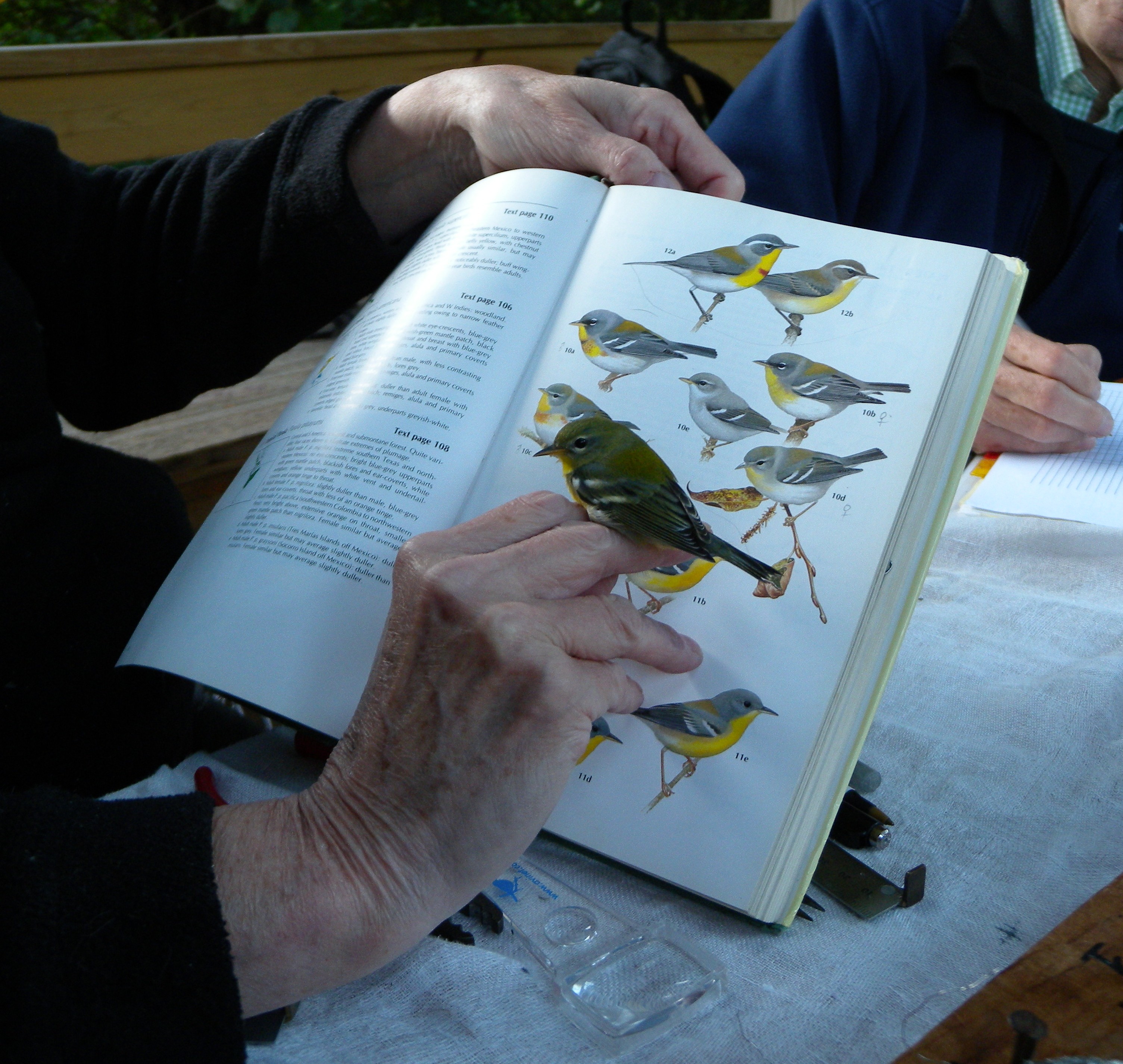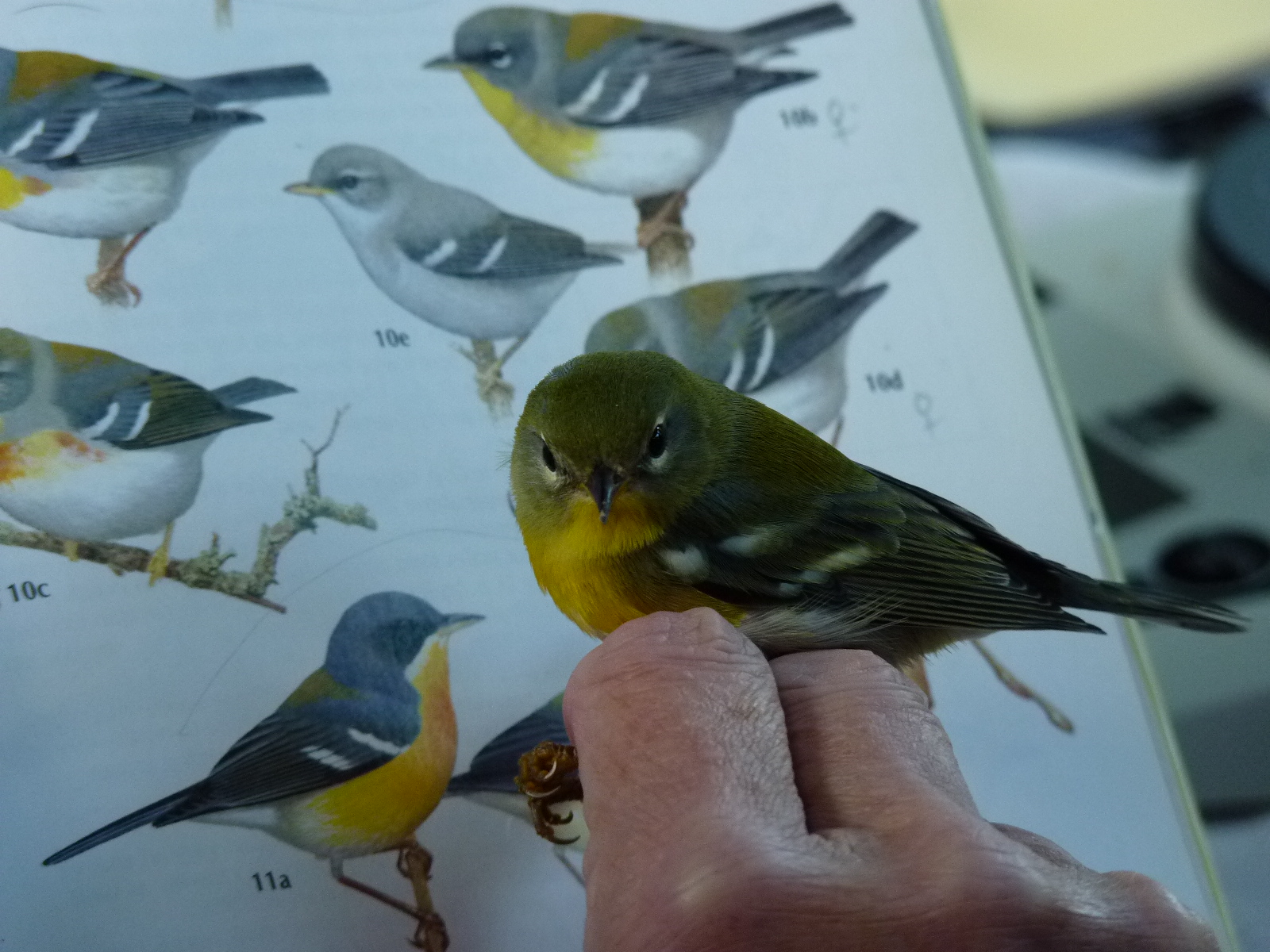NOTE: For those of you viewing this post by email, please remember to click on the title to read the post from the actual site for a better viewing experience.

Ode to a Bander’s Autumnal World
by Blake Goll
As the ardent air of autumn eclipses the weary haze of summer’s last breath,
The wind whispers to the wild wings that it is time.
Oh how the northern trees must weep as they somberly settle into winter solitude
And yearn for the intimate avian romance that enchants their days of green.
By most of mankind, the birds’ desperate southern voyage goes unseen.
But to the fortunate few, like you and me, this is the splendor we have feverishly awaited!
As if a million precious gems of a giant royal chest were catapulted south,
We scramble frantically to touch as many as we can before they continue spilling past,
Each jewel in hand more exquisite and exciting than the last.
Like secretive spiders faithfully tending their dewy webs by dawn’s dim light,
We raise our mist nets in hopes of gently snaring a few denizens of the sky;
A small silver ring upon the ankle, a reverent study of intricate feathers, then the rapturous release that leaves us breathless in awe,
Each lovely feathered captive feeds our hunger to understand
The storied lives of the heavenly birds with whom we share the land.

The feathered gems are indeed, flying southward in all earnest now. The wood warblers are still abundant, but the mid-fall migrants are beginning to show up, like the thrushes, kinglets and Yellow-rumped Warblers. The endless procession of catbirds still has not diminished and White-throated Sparrows have yet to reach us.


Yesterday, we banded 43 birds of eleven species for ten environmental educators from all over the country. The most notable birds were a beautiful first year female Northern Parula (only our third since 2010), a young Red-eyed Vireo (our second ever during migration banding) whose eyes were more brown than red, and the first Gray-cheeked Thrush of the season! We caught several Swainson’s Thrushes as well, distinguised from the Gray-cheeked by yellow orangish spectacles and buffy rather than gray cheeks. The Gray-cheeked Thrush is the most northen breeder of all America’s spotted thrushes and is infrequently seen; its gray pallor is a reflection of its austere tundra environment.



Heard and seen (but not netted) yesterday at the banding station were several small kettles of Broad-winged Hawk (nothing compared to the tens of thousands counted at DelCo and MontCo hawk watches), Red-breasted Nuthatch, and at least three Rose-breasted Grosbeaks. Sharp-shinned and Cooper’s Hawks circled over the net lanes looking for easy pickings.
We hosted 21 members of the Birding Club of Delaware County on Saturday and the staff of PA Audubon on Monday. Both of these days were relatively slow (around 35 birds each day), but the quality was stupendous! No one was mourning when a female Connecticut Warbler materialized and mesmerized with her quiet, rare beauty. This is a bird that evades most big time birders’ life lists, as I mentioned before, and it was our third of the season! Check out bird photographer Matt Levanowitz’s guest blog post on Nemesis Bird about his quest to find the mysterious Connecticut. Can somebody tell him he just needs to visit Rushton!?

Other birds banded earlier this week include Swainson’s Thrushes, Magnolia Warblers, Ovenbirds, Common Yellowthroat, Northern Cardinal, Yellow Shafted Flicker, Wood Thrush, Field Sparrow and one scruffy young male Eastern Towhee.





Though our banding crew was not able to be out last Sunday the 16th, it would have been great banding because there was a BIG flight over Southeastern PA the Saturday night before. I birded the woodlot behind my house in West Chester that morning from 9-10:30am, which is far too late by most birders’ standards. However, I really lucked out and got awesome close views of 13 migrant species bustling about: Chestnut-sided Warbler, Black-and-White Warbler, Black-throated Green Warbler, Northern Parula, Pine Warbler, Magnolia Warbler, Wood Thrush, Ruby-Crowned Kinglet, Rose-breasted Grosbeak, Red-eyed Vireo, Wood Pewee and my very first breath-taking BLACKBURNIAN WARBLERS! Who says you have to set your alarm at the crack of dawn for birding? My warblers were feeding so low in the understory at one point that I could actually hear their bills snapping as they chased the insects out from the leaves and into the open air near me. As close as they were though, it was still quite a task differentiating “confusing fall warbler” plumage. It’s much easier in the hand than when they are darting through the canopy!

Working my way backwards in news from Rushton banding station, last week we caught about 150 birds in 3 mornings. Perhaps the most thrilling catch was an itty bitty WIWA or Wilson’s Warbler on 9/11, only the second ever for Rushton! We measured the extensiveness of black on his head to determine he was an adult male. These handsome little guys breed largely in Canada and the Pacific Northwest.

That same day we also banded a trio of refined Cedar Waxwings: an adult female and two “kids”. Although we often hear and see Cedar Waxwing flocks feeding on berries and insects high in the hedgerow, this is the first time they have come down to our nets since fall of 2010.


On 9/11 we also banded three hatch year Song Sparrows, which we suspect are the ones born in the Tiger Stripe tomato plants this summer, a wonderful picture of the harmonious relationship between the sustainable farm and the birds.


At least two White-eyed Vireos were taunting us all last week, calling from the hedgerow, but never venturing into a net. However, at the end of the week we did manage to catch one young White-eyed Vireo! This is a fantastic bird with blue legs, an eery white, human-like eye and an uncanny resemblance to a miniature velociraptor, if you ask me.


Other birds banded last week include:
- Another female Connecticut Warbler!
- Black-and-White Warbler
- Northern Waterthrush
- Eastern Towhee
- Yellow Shafted Flickers
- Gray Catbird
- Common Yellowthroat
- House Wren
- Carolina Wren
- Ovenbird
- Northern Cardinal
- Magnolia Warbler
- Swainson’s Thrush
- Wood Thrush
- Veery
- Field Sparrow
- American Robin
- Young Indigo Buntings



Birds noted but not banded last week include a dozen or so American Wood Cocks, which we flushed at dawn’s first light from the fields, and a Common Nighthawk, which flew from its roost at the edge of the woods late one morning as we were closing the nets.
Songbird Banding Schedule
Rushton Banding Station is in operation and open to the public every Tuesday and Thursday mornings from 6am until 11am, unless it rains. In addition, we will be open to visitors Wednesday morning September 26th, 6am-11am.
Songbird banding runs until mid to late October when we start banding for Northern Saw-whet Owls. Stay tuned for more info about owl banding.


Things To Do This Weekend:
Run-A-Muck is TOMORROW September 22!
Come out to support the Willistown Conservation Trust’s land preservation efforts and enjoy a challenging run or leisurely walk through the most scenic trails of rural Willistown, not normally open to the public. Country supper, live music, wine, beer, movie under the stars, mechanical bull rides, prizes, raffle and more! Click here to find out more. Registration is only on a walk-in basis at this point, but you may still purchase raffle tickets online for a chance to win $5,000, even if you are not at the event!!
Hawk Mountain Art Show September 22-23
Check out the hawk watch and then enjoy the dozen talented wildlife artists who will have their artwork on display and for sale in the Visitor Center. Click here to learn more about the artists.
By the way, on Monday 2,806 migrant monarch butterflies passed by the Hawk Mountain lookout, a one-day record that beats the average SEASON total over the last 21 years of 1,804 monarchs! WOW.
There’s a lot going on out there,
~Blake


























